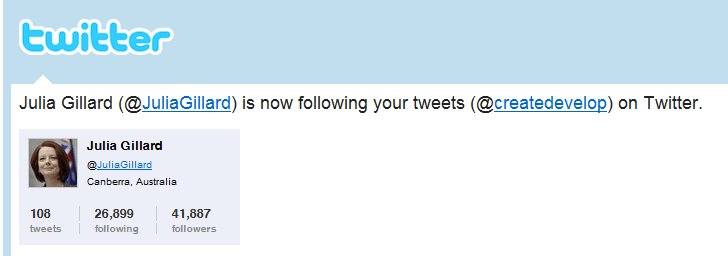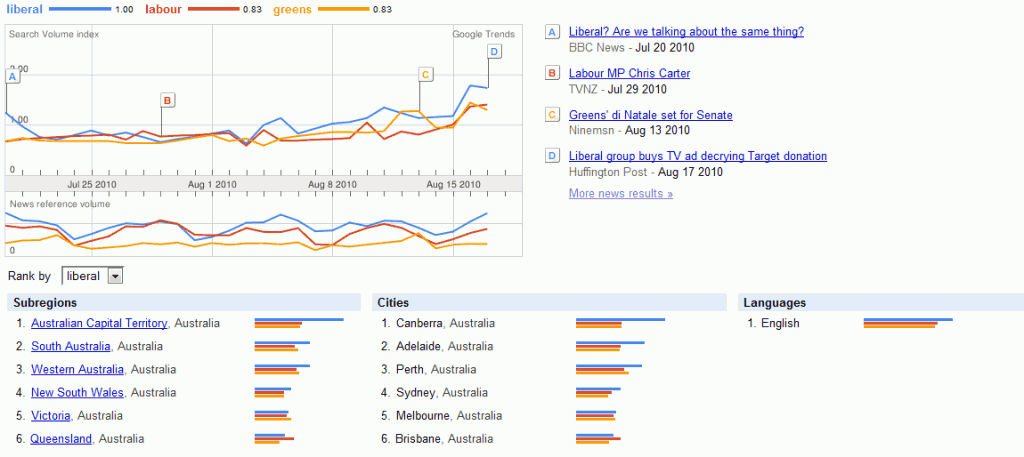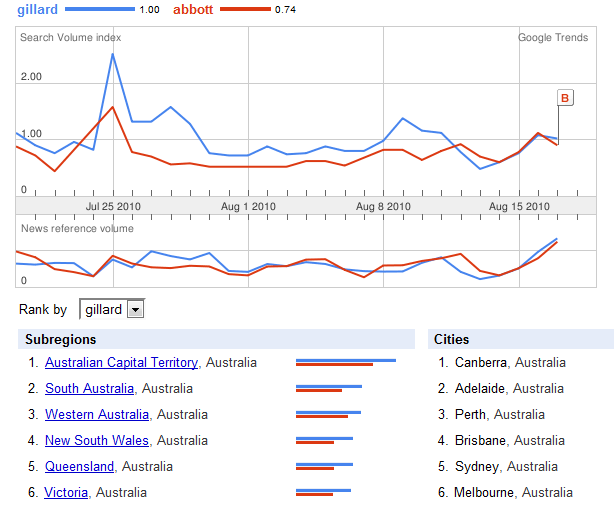All politics is local, unless you are on the Internet, in which case it is local and global all at the same time. Marketing and politics go hand in hand, but more so on the Internet, where people have the attention span of small children, and the emotional reactions to go with it. Often the leading edge of real world trends, the Internet has shown how business reputations, and legends, can be made good and bad by the slightest thing. Millions of dollars is being spent every year on online reputation management, for that reason alone.
Political parties cannot escape this trend. With the Australian Election tomorrow, we thought we would look at who/which parties have won the Internet war. We decided to analyse the political parties and their influence to see who has the online edge. The amount of information about online influence is staggering. If we had more time and money we would do this with every federal MP to see who is likely to take what seat. However, time is running out, so we have stuck with an overview. Maybe next time around we can create something more accurate and analyse the local level.
Google Trends shows that, over the last 15 days, the Liberals have been searched more frequently than Labour in all states except Queensland. Across Australia they have been ahead in both searches and news references. Obviously there can be a murkiness to these statistics, because people may not be searching for the federal labour or liberal parties, however there is no way of calculating the intent of users, so this is the best we can get. One an Internet search level, it is clear the Liberal party are ahead.
On a party leader level, Gillard and Abbott are neck and neck. Tony Abbott has been searched for more frequently for the last few months, and by subregion, he is ahead in all of the states. However, because the information pool is so small, the state level data is notoriously unreliable, so it is safer to look at the national information. Based on this information it is probably too close to call.
Tony Abbott and Julia Gillard’s Facebook pages are among the top 50 gainers in the last 30 days. This is a sign that politics has gone web 3.0 with the use of social networking. We are hoping for a “Super Poke” from Julia Gillard, or maybe Tony Abbott will trade with us on Farmville. Again, a sign that Australian politics is become more like America, the party leader’s pages have almost ten times the followers of the party itself.
So who is winning? At this stage Julia Gillard has 66,867 fans to Tony Abbott’s meagre 12,259. Julia has picked up 480 fans today alone. Maybe this is a reflection of the Liberal Party leader’s understanding of the inter-tubes. The trend is reversed when looking at the party level, as the Liberal Party has 14,358 with the Labour Party only 2650. We should also mention the Australian Greens have 19,659 fans. All these statistics are a reflection on the users and the appeal the parties have. Not only is the Liberal Party’s website much more interesting than Labour, it is more active and has more content. If the election were called based on how many people “like” Australian political parties, the Greens would be sharing power with the Liberals and Labour would be a minor party.
Again, maybe as a reflection on Tony Abbott’s grasp of technology, he is not following anyone, and only has 603 followers. Julia Gillard on the other hand has over 43000 followers and is following over 20000, including us! Julia, and her team, have really embraced Twitter. Julia’s influence is in the top 95% of people on the web, with her Twitter account clearly the center of many hubs. This time, the Greens’ Twitter following is more representative of their offline presence, with just over 3000 followers. On a party basis, the Liberal Party leads Labour 6100 followers to 4400 followers.
Analysing the Twitter influence of the major Australian parties is complicated by the fact that they have such poor followings. They barely rank in the top Twitter users of Australia, let alone globally. The Liberal Party however only has an impact score of 9% while Labour’s impact is at 14%, again showing that Labour fans are move active in their use of the internet. According to Twinfluence, the Australian Labour Party has a velocity of 2,958 second-order followers/day (in the top 7%) and social Capital of 169.1 (in the top 13%), compared to the Liberals with Velocity of 20,132 second-order followers/day (in the top 2%) on in the top 9% of social capital.
Based on all this data, we can say that if the election were to be decided on the Twitterverse alone, this would be a clear Liberal victory.
YouTube
Based on the number of views for videos created within the last 3 months, the Liberal party are storming ahead with 407,000 views to Labour’s 282,914. Not only has the Liberal Party created more videos, but they are entertaining and watchable. The Greens are again showing similar online and offline strength with just over 82,000 views. Even though earlier in the week, we thought The Greens had the most politically engaging videos, it seems the general public don’t care.The Liberal party certainly have the most entertaining, with their string of Labour Lemons cartoons, which may have turned things in their favour.
It seems that if the internet were to decide the election, Moot would probably win again. However, barring any attempt at vote rigging by 4chan, we think the Liberals have won the Internet election, by a nose, with Labour coming a close second. In a perfect, crowd-sourced world, Julia Gillard would be president, the Liberals would control the parliament and the Greens would have a significant stake in the senate.








